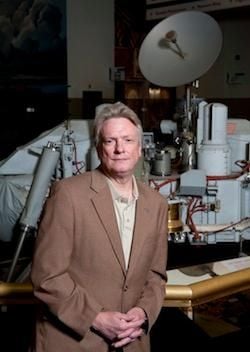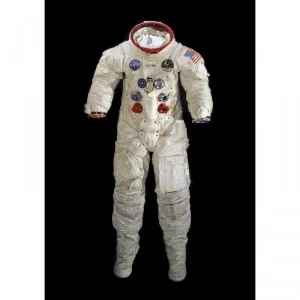Godspeed, Neil Armstrong — A Reflection on the Astronaut’s Life
Senior curator of the Air and Space museum remembers the man who united a country and walked on the moon
/https://tf-cmsv2-smithsonianmag-media.s3.amazonaws.com/filer/20120827100015AS11-37-5528_6401.jpg)
This post is part of our ongoing series in which ATM invites thoughts and commentary from among the Smithsonian Institution’s scientists, curators, researchers and historians, and originally appeared on the museum’s blog.

I first heard the sad news while having a late lunch with friends at a seafood restaurant on the water in Annapolis, Maryland. Neil Armstrong passed away today, August 25, 2012, from complications resulting from heart bypass surgery. He was 82 years old. We will all miss him, not just because he was the first human being in the history of the world to set foot on another body in the Solar System, but perhaps especially because of the honor and dignity with which he lived his life as that first Moon walker. He sought neither fame nor riches, and he was always more comfortable with a small group of friends rather than the limelight before millions. When he might have done anything he wished after his completion of the Apollo 11 Moon landing mission, Armstrong chose to teach aerospace engineering at the University of Cincinnati. Imagine having the first person to walk on the Moon as your engineering professor!
Neil Alden Armstrong was born on August 5, 1930, on his grandparents’ farm near Wapakoneta, Ohio. His parents were Stephen and Viola Armstrong. Because Stephen Armstrong was an auditor for the state of Ohio, Neil grew up in several Ohio communities, including Warren, Jefferson, Ravenna, St. Marys, and Upper Sandusky, before the family settled in Wapakoneta. He developed an interest in flying at age 2 when his father took him to the National Air Races in Cleveland, Ohio. His interest intensified when he had his first airplane ride in a Ford Tri-Motor, a “Tin Goose,” in Warren, Ohio, at age 6. At age 15 Armstrong began learning to fly at an airport near Wapakoneta, working at various jobs to earn the money for his lessons. By age 16 he had his student pilot’s license; all before he could drive a car or had a high school diploma.
He then went to Purdue University to study aeronautical engineering, but in 1949 he went on active duty with the Navy, eventually becoming an aviator. In 1950 he was sent to Korea, where he flew 78 combat missions from the aircraft carrier USS Essex.
After mustering out of the Navy in 1952, Armstrong joined the National Advisory Committee for Aeronautics (NACA). His first assignment was at NACA’s Lewis Research Center near Cleveland, Ohio. For the next 17 years he worked as an engineer, pilot, astronaut, and administrator for NACA and its successor agency, the National Aeronautics and Space Administration (NASA).
In the mid-1950s Armstrong transferred to NASA’s Flight Research Center in Edwards, California, where he became a research pilot on many pioneering high-speed aircraft—including the famous X-15, which was capable of achieving a speed of 4,000 mph. He flew over 200 different models of aircraft, including jets, rockets, helicopters, and gliders. He also pursued graduate studies and received a M.S. degree in aerospace engineering from the University of Southern California.
Armstrong transferred to astronaut status in 1962, one of nine NASA astronauts in the second class to be chosen. On March 16, 1966, Armstrong flew his first space mission as commander of Gemini VIII with David Scott. During that mission Armstrong piloted the Gemini VIII spacecraft to a successful docking with an Agena target spacecraft already in orbit. Although the docking went smoothly and the two craft orbited together, they began to pitch and roll wildly. Armstrong was able to undock the Gemini and used retro rockets to regain control of his craft, but the astronauts had to make an emergency landing in the Pacific Ocean.
On Apollo 11, Armstrong flew with Michael Collins and Edwin E. “Buzz” Aldrin, Armstrong completed the first Moon landing on July 20, 1969. As commander of Apollo 11, Armstrong piloted the lunar module to a safe landing on the Moon’s surface. On 20 July 1969, at 10:56 p.m. EDT, Neil Armstrong stepped down onto the Moon and made his famous statement, “That’s one small step for man, one giant leap for mankind.” Armstrong and Aldrin spent about two and one-half hours walking on the Moon collecting samples, doing experiments, and taking photographs. On July 24,1969, the module carrying the three astronauts splashed down in the Pacific Ocean. They were picked up by the aircraft carrier USS Hornet.

No question, the Moon landing unified a nation divided by political, social, racial, and economic tensions for a brief moment in the summer of 1969. Virtually everyone old enough recalls where they were when Apollo 11 touched down on the lunar surface and Neil Armstrong said his immortal words, “Houston, Tranquility Base here, the Eagle has landed.” Millions, myself included, identified with Neil Armstrong as he reached the “magnificent desolation” of the Moon. One seven-year-old boy from San Juan, Puerto Rico, said of the first Moon landing: “I kept racing between the TV and the balcony and looking at the Moon to see if I could see them on the Moon”. His experiences proved typical; as a fifteen-year-old I sat with friends on the hood of a car on the night of July 20, 1969, looking at the Moon and listening to the astronauts on it. “One small step,” hardly; Neil Armstrong nailed it with the second phrase of his famous statement, “one giant leap for mankind”.
Since that euphoric event a lot has passed, the world has changed, and the future does not seem to hold quite the same possibilities as it once did. Yet, Neil Armstrong captured that sense of hopefulness so well until his last breath. He was an American hero, no doubt, but he was more. He lived a life of quiet grace, rarely embroiling himself in the day-to-day fights we see all around us even as he exemplified a unique merger of the “Right Stuff” with the self-reflection of a poet. Landing on the Moon was singular accomplishment, but not one to be remembered as an accomplishment of Neil Armstrong, as he so often said. It was the result of the labor of hundreds of thousands and the accomplishment of generation of humanity. Armstrong always recognized the honor he received from humanity in being allowed to participate in Apollo 11.
Armstrong would have agreed with legendary journalist Walter Cronkite, about the experience of reaching the Moon. “Yes, indeed, we are the lucky generation,” Cronkite wrote. In this era we “first broke our earthly bonds and ventured into space. From our descendants’ perches on other planets or distant space cities, they will look back at our achievement with wonder at our courage and audacity and with appreciation at our accomplishments, which assured the future in which they live.” When those descendents do look back on that era when humanity first journeyed beyond Earth, I’m sure they will also remember the contributions of an unassuming engineer and pilot from Ohio in advancing the exploration of the cosmos. The most fitting tribute I can offer at this time of recollection was the same said on more than one occasion in the space program: “Godspeed, Neil Armstrong.”
Roger D. Launius is a senior curator in the museum’s Division of Space History.